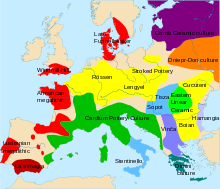
Back Kultura s vypíchanou keramikou Czech Stichbandkeramik German فرهنگ اشتیکبندکرامیک Persian Culture de la céramique décorée au poinçon French Cultura della ceramica decorata a punzone Italian Steekbandkeramiek Dutch Культура накольчатой керамики Russian
This article needs additional citations for verification. (July 2019) |
 | |
| Geographical range | Central Europe |
|---|---|
| Period | Neolithic Europe |
| Dates | c. 4900 BC — c. 4400 BC |
| Major sites | Goseck, Nickern |
| Preceded by | Linear Pottery culture |
| Followed by | Michelsberg culture, Funnelbeaker culture, Globular Amphora culture |

The Stroke-ornamented ware (culture) or (German) Stichbandkeramik (abbr. STK or STbK), Stroked Pottery culture, Danubian Ib culture of V. Gordon Childe, or Middle Danubian culture is the successor of the Linear Pottery culture, a major archaeological horizon of the European Neolithic in Central Europe. The STK flourishes during approximately 4900-4400 BC. Centered on Silesia in Poland, eastern Germany, and the northern Czech Republic, it overlaps with the Lengyel horizon to the south and the Rössen culture to the west.[1][2]
- ^ Borowskia, Michał P.; Furmanekb, Mirosław; Czarniakc, Krzysztof; Guniaa, Piotr (May 2015). "Steatite-tempered pottery of the Stroke Ornamented Ware culture from Silesia (SW Poland): a Neolithic innovation in ceramic technology". Journal of Archaeological Science. 57: 207–222. Bibcode:2015JArSc..57..207B. doi:10.1016/j.jas.2015.01.021. Retrieved 2 September 2021.
- ^ "Stroke-ornamented ware culture in Czech Republic". Czech Archaeology News. Retrieved 2 September 2021.